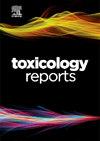A novel proficiency test to assess the animal diagnostic investigation process in identifying an unknown toxicant
Q1 Environmental Science
引用次数: 0
Abstract
Participation in Proficiency Tests (PTs) is an important component of quality assurance in testing laboratories. In a typical chemistry PT, blind-coded samples are sent to participants for analysis of specific chemical agents, and results are compared to a pre-determined key (e.g., expected concentrations) to assess proficiency. In the animal diagnostic PT presented here, organizers evaluated not only the analytical component of the diagnostic investigation but also the entire investigative process as a multi-step, holistic multidisciplinary approach. Fourteen veterinary diagnostic laboratories (VDLs) participated in an exercise to identify the root cause of a simulated case of lead (Pb) toxicosis. VDLs received a case description outlining neurological signs in cattle, a digitized brain histology slide, and liver and brain tissue samples for optional chemistry analysis. Thirteen of 14 VDLs successfully diagnosed lead toxicosis by completing the following stages: (a) correctly identifying histological abnormalities, (b) providing three adequate differential diagnoses, (c) selecting adequate chemistry analyses to rule in or rule out possible causes, (d) accurately detecting lead concentration in the liver, and (e) interpreting the diagnostic significance of their results correctly. Importantly, participants first had to determine which chemistry analyses were appropriate and then to accurately quantify the target analytes. This approach provided greater confidence in the diagnostic capability of the laboratory by reducing the bias associated with being given a known chemical contaminant for which to test, typical of most chemistry PTs, and may therefore be of interest to PT providers and accreditation committees.
一种新的能力测试,以评估动物诊断调查过程中识别未知毒物
参与能力测试(PTs)是测试实验室质量保证的重要组成部分。在典型的化学测试中,盲编码的样品被送到参与者进行特定化学试剂的分析,并将结果与预先确定的关键(例如,预期浓度)进行比较,以评估熟练程度。在这里介绍的动物诊断PT中,组织者不仅评估了诊断调查的分析部分,而且还评估了整个调查过程作为一个多步骤,整体多学科方法。14个兽医诊断实验室(vdl)参加了一项演习,以确定模拟铅中毒病例的根本原因。vdl收到了一份概述牛的神经学症状的病例描述,一份数字化的脑组织切片,以及用于可选化学分析的肝脏和脑组织样本。14个vdl中有13个通过完成以下阶段成功诊断出铅中毒:(a)正确识别组织学异常,(b)提供三种适当的鉴别诊断,(c)选择适当的化学分析来排除或排除可能的原因,(d)准确检测肝脏中的铅浓度,以及(e)正确解释其结果的诊断意义。重要的是,参与者首先必须确定哪种化学分析是合适的,然后准确地量化目标分析物。这种方法减少了与已知化学污染物相关的偏差,从而提高了对实验室诊断能力的信心,这是大多数化学PTs的典型特征,因此可能会引起PT提供商和认证委员会的兴趣。
本文章由计算机程序翻译,如有差异,请以英文原文为准。
求助全文
约1分钟内获得全文
求助全文
来源期刊

Toxicology Reports
Environmental Science-Health, Toxicology and Mutagenesis
CiteScore
7.60
自引率
0.00%
发文量
228
审稿时长
11 weeks
 求助内容:
求助内容: 应助结果提醒方式:
应助结果提醒方式:


